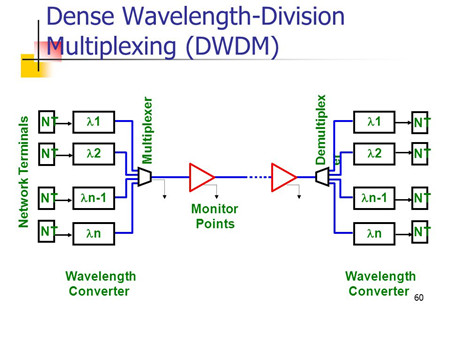Dense wavelength-division multiplexing (DWDM) as an emerging technology in fiber optic network, is devoted to increase the capacity of a single fiber, and thus the entire network in an cost effective way. A basic DWDM system typically includes these main components: a terminal multiplexer, an intermediate line repeater, and optical add-drop multiplexer (OADM), a terminal demultiplexer, and an optical supervisory channel. Transponders are currently a key element of the openness of DWDM systems that is used to convert incoming optical signals into the precise ITU-standard wavelengths to be multiplexed, which will be clearly discussed in this article.
Introduction to DWDM Technology
DADM technology is an extension of wavelength-division multiplexing (WDM) technology to arrange several fiber optic lights to transmit simultaneously via the same single fiber optic cable. Only one optical fiber is used between DWDM devices (per transmission direction). Instead of requiring one optical fiber per transmitter and receiver pair, DWDM allows several optical channels to occupy a single fiber optic cable. Figure 1 shows the diagram of DWDM technology.

A key advantage to DWDM is that it’s protocol and bitrate independent. DWDM-based networks can transmit data in IP, ATM, SONET, SDH and Ethernet. Therefore, DWDM-based networks can carry different types of traffic at different speeds over an optical channel. Voice transmission, email, video and multimedia data are just some examples of services which can be simultaneously transmitted in DWDM systems. DWDM systems have channels at wavelengths spaced with 0.4 nm spacing.
Wavelength-Converting Transponder Overview
As noted before, terminal multiplexer, intermediate line repeater, and optical add-drop multiplexer (OADM), a terminal demultiplexer, and an optical supervisory channel are the basic component of a DWDM system. Wavelength-converting transponder is present in the terminal multiplexer. Each signal in the fiber has a corresponding wavelength-converting transponder. This transponder is an optical-electrical-optical (O-E-O) wavelength converter and performs an O-E-O operation. That is the wavelength-converting transponder receives the input optical signal, converts that signal into the electrical domain and re-transmits the signal by using a 1550nm band laser. Seen in Figure 2, two switches are connected by the WDM transponders which convert the MMF to single mode fiber patch cables.

At this stage, more details of wavelength-converting transponders should be involved. Just as what is discussed above, wavelength-converting transponders served originally to translate the wavelength of a client-layer signal into one of the DWDM system's internal wavelengths in the 1,550nm band. In the mid-1990s, however, wavelength-converting transponders took on the function of signal regeneration. Signal regeneration in transponders evolved from 1R to 3R.
3R Functions of the Transponders
Transponders in terminal multiplexer used to only convert the wavelengths of incoming external signals into wavelengths (C-Band) that worked with the DWDM systems. This conversion also serves to stabilize the frequencies and amplify the power of these signals into something compatible with the EDFA in the DWDM system. The sophistication of the signal regeneration components in transponders grew as they progressed from 1R to 3R.
- 1R refers to retransmission. As the name implies, 1R does not employ any methods to “clean up” the signal. The transponders were “garbage in garbage out” since their output was nearly an analogue “copy” of the received optical signal, with little signal cleanup occurring. More specifically, if the incoming optical signal was “junk”, the analog version of it would be “junk” as well. Another consequence of 1R is that the practical distance of DWDM systems was limited because of the potential signal degradation inherent to long-reach communications.
- 2R means re-time and re-transmit. Before the incoming external signal is retransmitted, it first goes through a process to clean it up. Signal-quality monitoring was done at this point.
- 3R represents re-time, re-transmit, and reshape. Signal quality can be monitored more closely and accurately in this advance system as quality bits embedded in the signal are included, which tells the level of health and degradation of the signal for the system. The monitoring of bidirectional communication is possible in 3R systems.
Conclusion
Research is continuously advancing the DWDM technology to the point where 800 wavelengths on a single fiber could be feasible. The amount of data that modern applications require continues to grow. Wavelength-converting transponder is the key DWDM system component needed to facilitate the signal transmission. FS.COM offers a full range of WDM transponders, designed with high quality and high performance, which will ensure your high bandwidth requirement. Additionally, WDM components, such as WDM Mux/Demux and OADM, are all available.
评论
发表评论